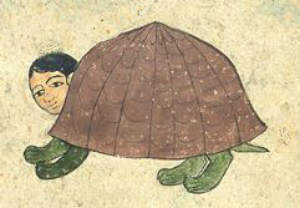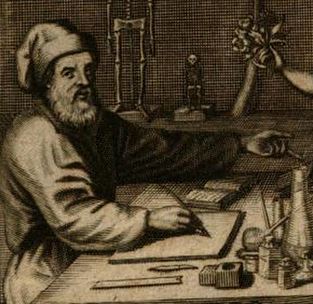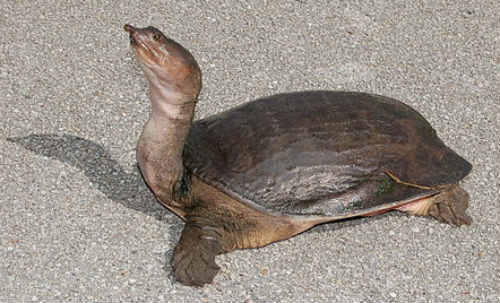Anthropochelonids
Mammalian Hybrids
|
If a woman gives birth, and the hands and feet of the child are like those of a turtle, the ruler will destroy the product of his land.
|
 An anthropochelonid (source: Zakariya al-Qazwini, Marvels of Things Created and Miraculous Aspects of Things Existing, 13th century).
An anthropochelonid (source: Zakariya al-Qazwini, Marvels of Things Created and Miraculous Aspects of Things Existing, 13th century).
For each different type of mammalian cross, I create a webpage that collects all serious reports about that cross. I do this whether or not I believe the reports myself. In this way I hope to eliminate one source of systematic bias from my work, which is intended to reveal, as much as possible, the true nature of the phenomenon of hybridization among mammals. If there are multiple independent reports of a given type of hybrid, then the idea that that cross actually occurs gains in credibility. But if there are few, such is not the case. And, for the cross currently under consideration, turtle x human—what we will here term anthropochelonids (/an-THOPE-oh-chel-OH-nidz/)—there are few. And yet, some do exist.
 Johann Nicolas Pechlin
Johann Nicolas Pechlin
Johann Nicolas Pechlin (1646-1706) was a Dutch physician who, late in life, served as tutor to the royal family of Sweden. In a book in which he reported cases that he had observed during the course of his medical practice (Observationum physico-medicarum libri tres, quibus accessit, Ephemeris, 1691, Observation 42, p. 316, Hamburgi), he describes a “boy” with the shell and appendages of a turtle, apparently rather similar to the creature pictured by Zakariya al-Qazwini at the top of this page. Pechlin's account reads,
There are also nineteenth-century news stories about anthropochelonids. According to one such report, a turtle-human hybrid was living in a poorhouse in Battle Creek, Michigan. His name was Samuel Keene. Stories about the Turtle-man, as he was known, appeared in newspapers all over the world. But the particular source of the following transcript was the front page of the May 25, 1880, issue of the Illawarra Mercury, a newspaper published in Wollongong, New South Wales, Australia (source).
A Human Monstrosity
A correspondent of the Chicago Inter Ocean, writing from Battle Creek, Michigan tells a remarkable story of the discovery of a monstrosity in the poorhouse of that state, known as “the turtle man.” The correspondent says that he visited the poorhouse to satisfy himself as to the truth of the numerous stories he had heard regarding this creature. The keeper of the institution introduced him to the monstrosity calling the four-foot-high dwarf, who stood before him, by the name of Samuel Keene. He says Keene, at the command of the keeper, managed, by a singular side movement of the body, and pushing his slouch hat from his head by his queer-shaped claws, to make a curtsey. As he stood before us, bareheaded, he presented the most wonderful specimen of man, amalgamated with the animal kingdom that can be imagined. On speaking with him, he apparently understood every word, but lacked sufficient intelligence to frame a reasonable answer, just as a dumb brute can comprehend, but cannot give an intelligent reply. In stature this singular being is short, thick-set, and flat rather than round. His legs and arms are short, the hands turning outward, the same as a turtle’s, and instead of fingers the widened palm ends in webbed claws. The feet are fashioned in the same manner, and when he walks it is with a sidelong, ambling gait, moving the entire side of the body in a manner peculiar to a tortoise. In his actions, and talk, he has a slow, measured, jerking style. The inside of his dirty claw or fin, which he held out to shake hands with, was of a yellow colour, as were also his feet and stomach, the skin having the same ribbed appearance and colour as the under part of a turtle. It was reported that he had a shell upon his back, but upon examination it was found to consist of tough layers of cuticle, which, however, are growing harder each year, and may soon become ossified. The peculiar colour of different portions of his body, some being dark and others white, has led to the conclusion that his flesh is multikind, or of different construction, in tissue. Although so small, he is thirty-two years of age. The most singular and startling feature of the monstrosity is the head, which seems but to be a continuance of the neck, with a flat face and head coming to a point at the top, the same as that of a snake. He is almost constantly moving his head and eyes from side to side. The back portion of his cranium is directly perpendicular to the neck, and covered with short, bristly, black hair, but no hair grows on any other portion of the body; no whiskers or moustache, only a few bristles at each corner of the mouth. The nose is flat, like an Ethiopian’s The mouth extends from jowl to jowl, very wide, and furnished with a full set of teeth. He constantly keeps his mouth open, with his large tongue lolling out, and it is this more than anything else that causes his unintelligible jargon. But the eyes are the most striking portion of his features. The whites are excessively large and lolling. The pupils small and black, look direct ahead, and possess a wild, staring, yet fascinating glare, very sharp and piercing, and glistening from underneath the broad eyebrows. In temper he is perfectly docile and harmless, unless aroused to anger, when he is sullen and snappish. In habits he is not very social, scarcely ever says anything unless spoken to, and, when young, never mingled with the boys, or engaged in juvenile sports. His parents were very poor, and both died when he was very young. He has brothers and sisters well off in worldly goods and respectable, but they refuse to support him, and he is a pauper upon the charity of the town. The cause of this terrible deformity is said to be a fright received by the mother previous to the child’s birth. It furnishes one of the most startling proofs of parental influence on record. The parents resided on Diamond Lake, and, being very poor, often caught fish for food. While fishing out of a boat one day, with her hands just touching the water and holding the line, an enormous turtle, attracted by the moving fingers, suddenly jumped up and bit her. She never recovered from the fright, and when the child was born, a few months afterwards, it had indelibly stamped upon its entire body the form of a turtle. It was not so noticeable at first, but grew with its growth and strengthened with its strength. The first habit which was noticeable was its device to creep turtle fashion, even after it could walk. Afterwards, upon examination by doctors, the joints of the arms and legs were found to be doubled and turned outwards like a tortoise. As the horrible truth grew upon the mother, the child became loathsome to her, and it was probably through shame and grief that the early death of the parent was due. During boyhood it was found impossible to educate the boy beyond a few words, which he utters hourly. As he has no memory of fact or incidents, he cannot tell even his age, or anything connected with his life; all is to him a blank. He exists only in the present, and, like the brute, seems to have no care for the morrow or sorrow for the past. In summer his great delight is to go bathing, and he will remain under water a long time. When a boy he had to be constantly watched lest he should drown, as his friends feared. He was a constant care to his parents during childhood, as he had to be fed, his claws or fins not being large enough to grasp food; but lately he has learned to feed himself. He is fondest of vegetable food and fish, but will eat anything he sees the rest of his fellow companions eat. He seems to have no passion or affection, and cares no more for the opposite sex than for his own. He takes the greatest pleasure, which is the only sense he seems to possess, in tending a baby, and for our amusement the keeper brought in an infant. Sam’s features lighted up with a smile which would have done credit to an Egyptian idol. His mouth opened still further, and his tongue protruded as he saw the child. Sitting down in a chair, and crossing his dwarfed limbs to form a cradle, he tenderly took the poor unfortunate infant left on the steps a few days before, and began to rock it with his knees, while he made a most singular low mumbling noise, which he called singing. Sammy, as he is called by all the inmates, has very little idea of the great world. All his world is the house and farm in which he lives. He seems to possess but little or no emotion, and upon the announcement of anyone’s death takes it as calmly as a call to dinner. He seems to be simply one grade above animal life, and as fit an argument for Darwin as could be wished.
 The notice above appeared in the Lake Charles, Louisiana, Echo (p. 5, col. 3, of the Jul. 26, 1879).
The notice above appeared in the Lake Charles, Louisiana, Echo (p. 5, col. 3, of the Jul. 26, 1879).
Another report of the same ilk appeared on the front page of the February 17, 1870, issue of The Home Journal, a newspaper published in Winchester, Tennessee (source). It originally appeared in the Memphis Appeal. It reads as follows:
MOST WONDERFUL
The Man-Turtle, or Turtle-Man
or the “What-is-It?”
We were informed some weeks ago by a gentleman of our acquaintance that there was at that time in the city the greatest of curiosities. He described it to us as a nondescript half human, half turtle, and withal not a hideous monstrosity. We declined to believe the statements of our friend at the time, but we have since had an opportunity of seeing this wonderful being, and convincing ourself of the truth of the statements originally made to us. It is now on exhibition on Second Street, between Madison and Monroe, and any of our reader who are skeptical can, like ourselves, have all doubts removed by a visit thither.
The creature is the likeness of nothing else under God’s blue canopy. It is about thirty inches in height, and when standing erect and looking towards one resembles somewhat the pictures of the dwarfs in the fairy books of our childhood. The feet are very large, being fully 11 inches in length, and are encased in stockings and slippers. The body is apparently all paunch, on which rests a very large but well-shaped human head, the face having a rather pleasant expression of countenance. The arms are short, and consist rather of a succession of joints, like the flips of a turtle, each arm being jointed thrice from the hand to the shoulder, and the joints being of such kind that the arm can be doubled up or bent in any direction. But the most wonderful thing in regard to the structure of this strange lusus naturae, is the fact that his back is covered with a shell exactly of the shape and substance as the shield of back of a soft-shell turtle, scales, marks and all. Around the margin of this shield the hide is marked like the skin of a rattle-snake. The creature speaks three languages, English, French and Choctaw; walks equally well on his hands as on his feet, and better on all fours than either, and is as much at home in the water as on dry land. His face wears a perpetual grin. His keeper says that he is always in a good humor. He eats anything that other humans do, and has other human attributes. He is inordinately fond of whiskey and the girls! In response to our questions he told us that he came from Brazil when twelve years old, and has lived since in the Choctaw Nation, he being now twenty-one years old. His mother is a South American, and his father a Frenchman, who for twenty years has been a trapper in the Indian Territory. In this limited sketch we have only been able to speak of the more striking and remarkable features of this wonder, but we vouch for the truth of our statements, and invite all who wish to see for themselves to call immediately at the booth, on Second Street near Madison.—Memphis Appeal
 A soft-shell turtle
A soft-shell turtle
Report about a boy with turtle foot >>
Most shared on Macroevolution.net:
Human Origins: Are we hybrids?
On the Origins of New Forms of Life
Mammalian Hybrids
Cat-rabbit Hybrids: Fact or fiction?
Famous Biologists
Dog-cow Hybrids
Georges Cuvier: A Biography
Prothero: A Rebuttal
Branches of Biology
Dog-fox Hybrids